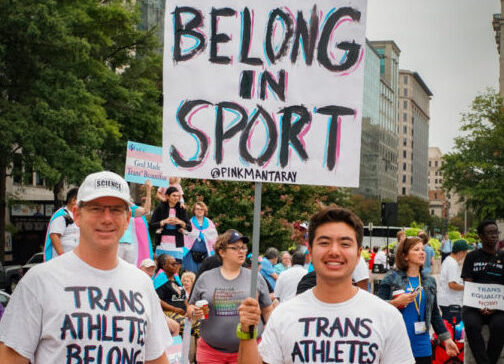Trans-feminine Athletes: Category Controversy

Support for trans athletes are expressed on the streets of Washington D.C. Courtesy of Ted Eytan.
There has been an ongoing debate in regard to the participation of trans-feminine athletes in women’s sports. Trans-feminine people are those who identify as female despite how they were assigned as male at birth; many go through surgeries and procedures, but especially for athletes, many procedures are required to compete. Although there are undoubtedly significant challenges that these individuals face when it comes to participation in athletics, many believe that allowing trans-feminine athletes to compete in women’s sports makes the competition no longer fair.
In March of 2022, Lia Thomas, the first trans-feminine swimmer who won the NCAA championship, sparked controversy around her victory. Many deemed that the title that she earned was unjust, as she went through “male puberty”. Therefore, her body does not quite have the same build as other women, giving her an edge when it comes to athletics.
One of the main reasons why some argue that trans-feminine athletes should not interfere with women’s athletics is that they may have higher levels of testosterone, a steroid hormone more present in males, as the NIH (National Library of Medicine) states how it, “increases muscle mass by increasing muscle protein synthesis.” However, many would refute this claim since this does not apply to all transgender athletes; hormone therapy is a common procedure that lowers testosterone levels within one’s body, significantly reducing the physical advantage one may have possessed. Dr. Joanna Harper, a medical physicist and transgender runner, argues that the focus on testosterone levels is misplaced. “People assume that testosterone is the only thing that matters in sports performance, but that’s not true,” she says. “There are many other factors, such as training, nutrition, and genetics, that also play a role.”
Human rights is another factor being brought up, as many suggest that not allowing trans-feminine athletes to compete with other women strips away how they identify themselves. “Transgender women are women, and should have the right to compete in women’s sports,” says Chris Mosier, a transgender athlete and advocate. “This is about basic human dignity and respect.”
On the other hand, some also argue that transgender athletes should hold their own category and not compete against cisgender athletes. “I think it’s unfair to allow someone who has gone through male puberty to compete against women,” says Martina Navratilova, a former professional tennis player, and outspoken critic of allowing trans-feminine athletes to compete in women’s sports. “It’s a matter of biology,” Navratilova believes that it is essential to find a balance between inclusivity and fairness. “We need to be inclusive and open, but we also need to be fair…there needs to be a level playing field.” she finally says.
The outcome regarding the participation revolving around trans-feminine athletes requires careful consideration. However, there are already new rules being implemented to tighten restrictions on transgender women’s athletics. “Decisions are always difficult when they involve conflicting needs and rights between different groups, but we continue to take the view that we must maintain fairness for female athletes above all other considerations,” says World Athletics president Sebastian Coe.





